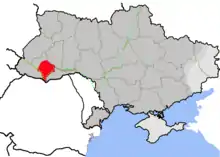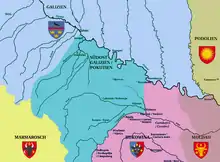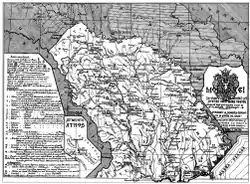Pokuttya
Pokuttya or Pokuttia (Ukrainian: Покуття, Romanian: Pocuția, Polish: Pokucie, Russian: Покутье) is an historical area of East-Central Europe, situated between the Dniester and Cheremosh rivers and Carpathian Mountains, in southwestern part of modern Ukraine. Historically it was a culturally distinct area inhabited by Ukrainians and Romanians on the previously unpopulated borders between Lviv and Halych. Although the historical centre of the area was Kolomyia, the name itself is derived from the town of Kuty that literally means 'round the corner' ("Kut" by itself means "corner"). The region is now inhabited mainly by Ukrainians.


History
Having been a part of Kyivan Rus and then one of its successor states, Halych-Volhynia in the early medieval period, the area was conquered by the Kingdom of Poland in 1325, and later annexed in 1349 by Casimir III of Poland.
Władysław II Jagiełło, needing financial support for his battles against the Teutonic Knights, used the region as a guarantee for a loan which he obtained from Petru II of Moldavia, who himself gained control of the region in 1388. Petru was eager to gain influence in the internal politics of the Kingdom of Poland, supporting the cause of his long-time allies, the Jagiellons of the Grand Duchy of Lithuania. Pokuttia, thus, became the feudal property of the princes of Moldavia, but remained within the Kingdom of Poland. As in other such famous 'deals' in medieval Europe (e.g. Foix, or the Dauphiné), when the local feudal lord had to swear an oath of allegiance to the king for the specific territory, even when the former was himself an independent ruler of another state. Consequently, the region became a matter for judicial and military dispute between the two countries, because the debt was never repaid in full by Poland.

In 1485, Moldavian prince Stephen the Great, having lost his country's access to the Black Sea the previous year to the Ottomans, was in serious need of alliances, and swore allegiance to Casimir IV Jagiellon, King of Poland for Pokuttia, in what is known as the Colomeea oath.[1] However, Casimir's successor, John I Albert of Poland, used the treaty as a pretext to invade Moldavia itself in 1497. Even after four months of siege, he failed to take the fortress of Suceava, Stephen's capital, and abandoning the siege, his army ran into a trap that caused many of his nobles to die (see Battle of the Cosmin Forest).
In 1498, Pokuttia was conquered by Stephen the Great, annexed and retained by Moldavia until the Battle of Obertyn in 1531, when it was recaptured by Poland's hetman Jan Tarnowski, who defeated Stephen's son Petru Rareş. Minor Polish-Moldavian clashes for Pokuttia continued for the next 15 years, until Petru Rareş's death. Throughout Middle Ages, Obertyn was Pokuttia's main castle, while Kolomyia was the region's main market town and fair.
Following the Partitions of Poland of 1772, Pokuttya fell under the Habsburg Monarchy.
Language
The territory of Pokutia had been part of Moldavia since the 14th century. The Moldavian state had appeared by the mid-14th century, eventually expanding its territory all the way to the Black Sea. Bukovina and neighboring regions were the nucleus of the Moldavian Principality, with the city of Iasi as its capital from 1388 (after Baia and Siret).[2] When Moldova established its control over part of Pokutia and Bukovina occurred a process of romanization. Moldavian language influenced the language spoken by locals, and the Pokutia-Bukovyna dialect was formed. It is distinct from other Ukrainian dialects because all of them are influenced by other Slavic languages, while the Pokutia-Bukovyna dialect was formed under the influence of Romance languages. The dialect preserved several archaic endings and soft declension, and certain lexical peculiarities, including Rumanianisms. The expansion of ancient Pokutian phonetic features in the 14th-16th centuries in western Podolia contributed to the formation of a broader group of Dniester dialects.
Modern times
In the wake of the World War I and the fall of Austria-Hungary, it became disputed between Poland and the short-lived West Ukrainian People's Republic, which had its seat of government in Stanyslawiw after it failed to hold Lwow. In May 1919, Polish and Romanian forces occupied Pokuttya in order to create a corridor between Poland and Romania. In August 1919, the Romanian Army handed eastern Pokuttya over to Poland.[3] After the Polish-Soviet War, it remained in Poland.
As a result of the 1939 invasion and partition of Poland by Nazi Germany and the Soviet Union, the area was initially attached to the Ukrainian Soviet Socialist Republic, falling to Nazi control after the start of Operation Barbarossa until 1944. It was then incorporated into the Soviet controlled Western Ukrainian oblast of Ivano-Frankivsk, roughly corresponding to the southern half of the oblast.
Pokuttya's population still contains today some Romanian and Ukrainian Hutsul communities. At the 2001 census there were 600 Romanians and Moldovans recorded.
References
- In local folklore it is held that Casimir ordered the tent where the oath was taking place to be suddenly uncovered, so as to show Stephen on his knees in front of his nobles and escort. It is said that Stephen, renowned for his religious piety, quickly turned towards an icon and crossed himself, in order not to appear shamed in front of his men.
- "Southwestern dialects". www.encyclopediaofukraine.com. Retrieved 2020-11-09.
- Philippe Henri Blasen: Pocuce, injuste prius detractum, recepit... Rumänische Ansprüche auf die südostgalizische Gegend Pokutien ? In: Analele Bucovinei, 1/2014
List of towns
- Deliatyn (Delyatyn)
- Hody-Dobrovidka
- Kobaky
- Kolomyia (Polish: Kołomyja, Romanian: Colomeea)
- Kosiv
- Kosmach
- Kuty, Stari Kuty (Romanian: Cuturi)
- Lanchyn
- Pechenizhyn
- Obertyn (Romanian: Obertin)
- Verkhovyna
- Vorokhta
- Yabluniv
- Yaremche
- Zabolotiv
- Carpathian National Nature Park